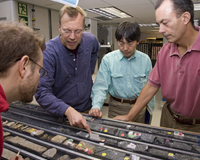| . |  |
. |
Washington (AFP) April 18, 2010 An ocean census has revealed a "new world" of richly diverse marine microbe life that could help scientists understand more about key environmental processes on Earth, a study said Sunday. Scientists participating in the International Census of Marine Microbes (ICoMM) said they had uncovered an astonishing array of hard-to-see marine lifeforms, including microbes, zooplankton and larvae. Traditional research methods have already isolated some 20,000 marine microbes, but new data suggests the true numbers are much higher. "The total number of marine microbes, including both bacteria and archaea (single-cell microorganisms), based on molecular characterization, is likely closer to a billion," said ICoMM's scientific advisory council chair John Baross, of the University of Washington. The marine microbes in fact constitute somewhere between 50 to 90 percent of all ocean biomass, and by volume weigh the equivalent of 240 billion African elephants, according to the researchers. "In no other realm of ocean life has the magnitude of Census discovery been as extensive as in the world of microbes," said Mitch Sogin, of the Marine Biological Laboratory in Massachussetts. Determining the number, variety and role of different forms of marine microbes provides key insight into "the size, dynamics and stability of the Earth's food chain, carbon cycle and other planetary fundamentals," researchers said. This marine life is responsible for over 95 percent of respiration in the oceans, thereby helping to maintain the conditions humans need to survive on Earth, they added. They function as key recyclers, turning atmospheric carbon dioxide absorbed by the ocean into carbon that goes back into the ground. They perform similar functions for nitrogen, sulfur, iron, manganese and other elements. Among other discoveries made by the research was the location of massive "mats" of microbes that carpet areas of sea floor. One located off the west coast of South America covers a surface comparable in size to Greece and is among Earth's largest masses of life, researchers said. The study also found that some microbes and bacteria formed symbiotic relationships with marine animals, living on their skin or in their guts. The revelation could uncover hundreds of millions of new microbial species and provides "a huge frontier for the next decade," Baross said. The research was conducted at more than 1,200 sites worldwide, allowing scientists to amass 18 million DNA sequences of microbial life. The latest finding is part of the decade-long research involved in the ocean census, which will conclude October 4 with closing ceremonies in London. Involving more than 2,000 scientists from more than 80 nations, the census is one of the largest global scientific collaborations ever undertaken, according to organizers.
Share This Article With Planet Earth
Related Links Water News - Science, Technology and Politics
 Deciphering The Mysteries Of An Ancient Seafloor Goliath
Deciphering The Mysteries Of An Ancient Seafloor GoliathWashington DC (SPX) Apr 13, 2010 The eruptions of "supervolcanoes" on Earth's surface have been blamed for causing mass extinctions, belching large amounts of gases and particles into the atmosphere, and re-paving the ocean floor. The result? Loss of species, increased greenhouse gases in the atmosphere, and changes in ocean circulation. Despite their global impact, the origin and triggering mechanism of these eruptions r ... read more |
|
| The content herein, unless otherwise known to be public domain, are Copyright 1995-2010 - SpaceDaily. AFP and UPI Wire Stories are copyright Agence France-Presse and United Press International. ESA Portal Reports are copyright European Space Agency. All NASA sourced material is public domain. Additional copyrights may apply in whole or part to other bona fide parties. Advertising does not imply endorsement,agreement or approval of any opinions, statements or information provided by SpaceDaily on any Web page published or hosted by SpaceDaily. Privacy Statement |